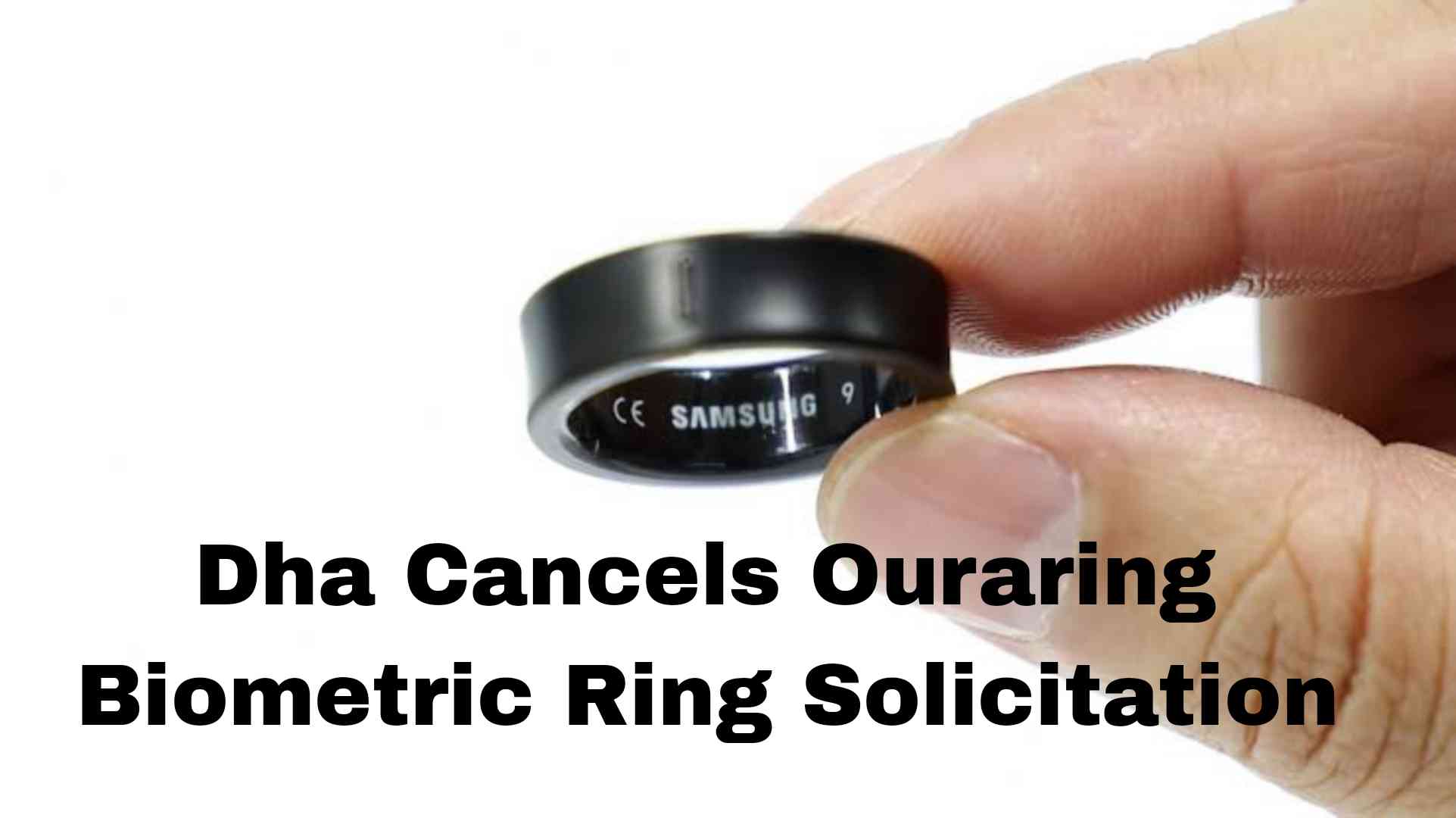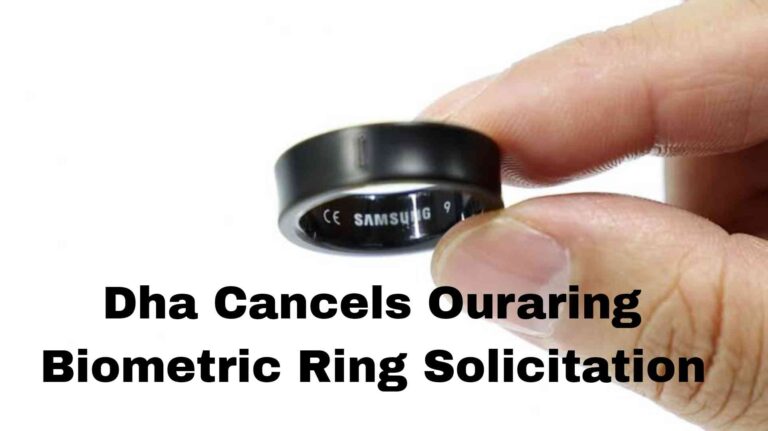
Dha Cancels Ouraring Biometric Ring Solicitation—In a decision that’s raising eyebrows across the digital health and wearable tech space, the Defense Health Agency (DHA) has quietly canceled its previously announced solicitation for the Oura Ring biometric device. The news—though underreported—carries significant implications for the future of military-grade health monitoring, biometric data privacy, and the broader conversation about wearable technology in defense environments.
So, what exactly happened? Why did the DHA cancel the Oura Ring solicitation? And what does it mean for the future of biometric wearables in high-security domains like the U.S. military? Let’s unpack the full story—and what it might signal for 2025 and beyond.
What Was the DHA’s Oura Ring Solicitation All About?
Earlier this year, the Defense Health Agency (DHA)—an integrated combat support agency within the Department of Defense—issued a formal solicitation exploring the procurement of the Oura Ring, a smart wearable device that tracks biometric metrics such as sleep, heart rate variability (HRV), body temperature, and respiratory patterns.
The solicitation aimed to assess whether this compact, ring-based device could be integrated into the military’s health readiness systems. Specifically, DHA was looking to use the Oura Ring to:
-
Monitor fatigue and recovery in high-stress operational environments
-
Collect longitudinal biometric data for predictive health modeling
-
Support readiness assessments in both training and deployment settings
But just weeks after floating the idea through public procurement channels, the DHA quietly withdrew the solicitation—without much explanation.
Why Did the DHA Cancel the Oura Ring Biometric Ring Solicitation?
While the agency hasn’t issued a detailed statement, multiple factors likely played into the decision. Based on insider feedback and defense tech analyst insights, here are the most probable reasons:
1. Data Privacy and National Security Concerns
At the heart of the issue is the handling and storage of biometric data. The Oura Ring stores user health data on servers that, while HIPAA-compliant, are not always within U.S. federal cloud infrastructures. In military settings—where even minor data leaks can compromise national security—this poses a red flag.
There’s also concern about foreign access to U.S. soldier biometric information, especially given ongoing scrutiny around tech firms with international ties. While Oura is headquartered in Finland, questions remain about third-party data handling and potential cross-border information flows.
2. Lack of Customization for Military Use
The commercial Oura Ring is a consumer-grade product. While it excels in tracking sleep and recovery for civilians, it lacks certain features the DHA likely needed, including:
-
Custom APIs for DoD-level integration
-
Encrypted real-time streaming to secure defense networks
-
Interoperability with military-grade health systems and wearable dashboards
Without robust customization options, the ring may have simply fallen short of DoD’s operational requirements.
3. Procurement Pressure and Public Scrutiny
Federal procurements—especially those involving health and surveillance tech—are increasingly scrutinized by watchdog groups and Congress. The Oura Ring’s solicitation may have triggered oversight friction, especially amidst rising debates on informed consent, biometric surveillance, and wearable ethics.
Additionally, the growing trend of private tech being co-opted for public surveillance missions (as seen in recent Amazon and Palantir controversies) likely added fuel to the fire.
The Broader Implications for Wearable Tech in the Military
Dha Cancels Ouraring Biometric Ring Solicitation—The DHA’s cancellation doesn’t just affect Oura. It signals a broader cautionary shift in how the military approaches commercial wearable tech. This isn’t the first time defense bodies have flirted with consumer products only to retreat at the last minute—Google Glass and Fitbit saw similar fates in various pilot programs.
Let’s look at what this cancellation could mean in the bigger picture.
Data Sovereignty Is Now Non-Negotiable
Expect future solicitations to come with stricter data localization requirements. Wearable vendors seeking military contracts may soon be required to store all data on FedRAMP-certified government cloud servers, with zero tolerance for external data sharing.
Consumer-Grade Tech Needs Tactical-Grade Overhaul
Companies like Oura, Whoop, or even Apple will need to harden their platforms for tactical use if they want to compete in military RFPs (Requests for Proposal). That includes:
-
Offline syncing
-
Mission-mode durability
-
Compliance with MIL-STD-810 for environmental stress testing
Transparency and Ethics Will Define Future Contracts
One thing the Oura case makes clear: public perception and ethical accountability now matter just as much as technical performance. Defense tech vendors will need to prove their systems respect privacy, maintain transparency, and offer opt-in choices—even in hierarchical command chains.
Why the Oura Ring Was Initially Appealing to the DHA
Despite the cancellation, it’s important to understand why the DHA even considered the Oura Ring in the first place. The device does offer compelling benefits—especially for a military grappling with chronic fatigue, post-deployment stress, and readiness breakdowns.
Key Features That Caught DHA’s Interest:
| Feature | Military Relevance |
|---|---|
| Sleep Score | Helps identify under-rested personnel before critical missions |
| HRV Tracking | Useful for monitoring chronic stress and fatigue |
| Temperature Trends | Can serve as an early illness detection system |
| Minimal Form Factor | Doesn’t interfere with combat gear or gloves |
But as useful as these features are, form factor alone doesn’t equal mission readiness. Ultimately, the ring’s lack of direct integration with secure health IT ecosystems and insufficient control over backend data pipelines likely led to its downfall in this context.
What Comes Next for the DHA and Biometric Monitoring?
Dha Cancels Ouraring Biometric Ring Solicitation—Just because the Oura Ring is off the table doesn’t mean the idea is dead. On the contrary, the DHA’s interest in biometric wearables is only growing. We’re likely to see new solicitations in the coming months—only this time, with more tailored specifications.
Here’s what insiders believe the future will look like:
1. In-House or Federally Approved Wearables
Instead of outsourcing to consumer brands, the DoD might partner with U.S.-based defense startups or develop proprietary devices. Think ruggedized wearables built from the ground up for military use.
2. Increased Collaboration with Research Labs
Federal research centers like DARPA and NIH’s BRAIN Initiative are already experimenting with advanced biometrics. Expect tighter collaboration between research entities and the DHA to co-create next-gen devices.
3. Stronger Vetting and Pilot Testing Phases
Any future programs will go through extensive vetting, stress testing, and ethical reviews. The days of quickly adapting off-the-shelf wearables to military roles may be over.
Final Thoughts: A Wake-Up Call for the Wearable Industry
Dha Cancels Ouraring Biometric Ring Solicitation—The cancellation of the DHA’s Oura Ring solicitation isn’t just a bureaucratic hiccup—it’s a wake-up call to the entire healthtech ecosystem. If wearable companies want to make the leap from lifestyle tracking to mission-critical readiness, they’ll need to think beyond glossy apps and gamified dashboards.
They must:
-
Build for privacy-first use cases
-
Prioritize transparent data ownership
-
Engage defense stakeholders early in development
For now, the Oura Ring remains a gold standard in consumer wellness. But in the defense world? The standards are just a little higher—and the consequences, far more serious.
FAQs: DHA Cancels Oura Ring Biometric Ring Solicitation
Why did the DHA want to use the Oura Ring in the first place?
The DHA was exploring whether the Oura Ring could help track sleep, fatigue, and overall readiness in military personnel. It offers compact form and rich biometric tracking, making it an attractive option for field use.
What specific concerns led to the cancellation?
While no official reason was publicly disclosed, the most likely issues were data privacy, national security risks, lack of military customization, and concerns over data hosting outside secure U.S. environments.
Could the Oura Ring still be used in non-military health applications?
Absolutely. The Oura Ring continues to be a popular tool for civilian health and wellness tracking, including use in elite sports teams, clinical research, and corporate wellness programs.
Are there any military-grade alternatives to the Oura Ring?
Currently, few exist in the public market, but companies like Garmin, Hexoskin, and even WHOOP are exploring defense-grade options. Meanwhile, some DoD labs are reportedly developing proprietary wearables.
Will biometric tracking become more common in the military?
Yes. Despite the cancellation, interest in biometrics remains strong. The focus will likely shift toward custom-built or heavily vetted solutions that align with strict privacy, security, and operational standards.






